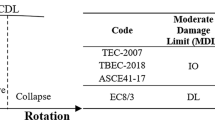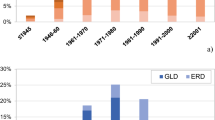Abstract
This paper presents seismic fragility assessment of RC high rise-buildings for seismic excitation, typical for Southern Euro-Mediterranean zone. The fragility curves were derived and log-normal cumulative distribution function parameters were obtained for the four defined damage states by conducting 3600 nonlinear time-history analyses on the basis of 60 ground motions with wide range of magnitudes, distance to source and different site conditions, including in this way uncertainties during ground motion selection. As a prototype buildings, 20-story, 30-story and 40-story RC high-rise buildings with core wall structural system were chosen. The key points of the process for obtaining the fragility curves are shown by using algorithm, defined in this paper, and generally applicable to all types of RC high-rise buildings. For the purpose of conducting nonlinear time-history analyses, non-linear 3D models of the buildings were designed. A detailed probabilistic seismic damage analysis was done and as its result the limit states as well as corresponding damage states for RC high-rise buildings were defined, where the damage states were treated as random variables. Inter-storey drifts at threshold of damage state were defined as random variables with the range of possible values. Since no probabilistic fragility curves exist for this class of buildings and for this seismic zone, this work partially fills the void in Southern Euro-Mediterranean seismic risk assessment. The whole approach presented in this paper may be used for efficient obtaining probabilistic fragility curves for RC high-rise buildings of different configurations.



















Similar content being viewed by others

References
Ambraseys N, Smit P, Sigbjornsson R, Suhadolc P, Margaris B (2002) Internet-site for European strong-motion data. European Commission, Directorate-General XII, Environmental and Climate Programme, Brussels. http://www.isesd.cv.ic.ac.uk
CEN EC8 (2004) Eurocode 8-1—design of structures for earthquake resistance. Part 1: general rules, seismic actions and rules for buildings. European standard EN 1998-1, December 2004, European Committee for Standardization, Brussels
CEN EC2 (2004) Eurocode 2—design of concrete structures. Part 1: general rules and rules for buildings. European standard EN 1992-1-1, December 2004, European Committee for Standardization, Brussels
CEN EC8 (2005) Eurocode 8-2—design of structures for earthquake resistance. Part 2: bridges Annex E probable material properties and plastic hinge deformation capacities for non-linear analyses. European standard prEN 1998-2, November 2004, European Committee for Standardization, Brussels
CSI (2006) PERFORM 3D nonlinear analysis and performance assessment for 3D structures. Computers & Structures Inc., Berkeley
CSI (2007) PERFORM 3D detailed example of a tall shear wall building by Dr. Graham H. Powell. Nonlinear modeling, analysis and performance assessment for earthquake loads. Computers & Structures Inc., Berkeley
CSI (2013) ETABS 2013 integrated analysis, design and drafting of buildings systems. Computers & Structures Inc., Berkeley
Erberik M, Elnashai A (2004) Fragility analysis of flat-slab structures. Eng Struct 26(2004):937–948. doi:10.1016/j.engstruct.2004.02.012
FEMA 356 (2000) Prestandard and commentary for the seismic rehabilitation of buildings. Federal Emergency Management Agency, Washington
Ghobarah A (2004) On drift limits associated with different damage levels. In: Proceedings of an international workshop on performance-based seismic design concepts and implementation, Bled Slovenia, pp 321–332
Giardini D, Woessner J, Danciu L, Crowley H, Cotton F, Grünthal G, Pinho R, Valensise G and the SHARE consortium (2013) SHARE European seismic hazard map. European Commission. www.share-eu.org
Ji J et al. (2007) Seismic fragility assessment for reinforced concrete high-rise buildings. Report 07-14, Mid-America Earthquake Center, University of Illinois at Urbana-Champaign
Ji J, Elnashai AS, Kuchma DA (2007) An analytical framework for seismic fragility analysis of RC high-rise buildings. Eng Struct 29(2007):3197–3209. doi:10.1016/j.engstruct.2007.08.026
Ji J, Elnashai AS, Kuchma DA (2009) Seismic fragility relationships for reinforced concrete high-rise buildings. Struct Des Tall Spec Build 18:259–277. doi:10.1002/tal.408
MATLAB (2013) MATLAB—the language of technical computing, version R2013b 8.2.0.701. MathWorks Inc., Natick
National Institute of Building Sciences (1999) HAZUS technical manual, prepared for Federal Emergency Management Agency, Washington, DC
Park YJ, Ang AHS (1985) Mechanistic seismic damage model for reinforced concrete. J Struct Eng 111(4):722–739
PEER (2010) Technical report for the peer ground motion database web application. Pacific Earthquake Engineering Research Center, University of California, Berkeley
Rossetto T, Elnashai A (2003) Derivation of vulnerability functions for European-type RC structures based on observational data. Eng Struct 25(2003):1241–1263. doi:10.1016/S0141-0296(03)00060-9
Taranath BS (2010) Reinforced concrete design of tall buildings. International Code Council, Concrete Reinforcing Steel Institute, CRC Press Taylor & Francis Group, Boca Raton
The Council on Tall Buildings and Urban Habitat (2011) The tallest 20 in 2020: entering the era of the Megatall. Illinois Institute of Technology, Chicago. http://www.ctbuh.org/TallBuildings/HeightStatistics/BuildingsinNumbers/TheTallest20in2020/tabid/2926/language/en-US/Default.aspx
Wallace JW (2012) Behavior, design, and modeling of structural walls and coupling beams—lessons from recent laboratory tests and earthquakes. Int J Concr Struct Mater 6(1):3–18. doi:10.1007/s40069-012-0001-4
Acknowledgments
The authors sincerely thank Seismological Institute of Montenegro for sharing data from its ground motions database.
Author information
Authors and Affiliations
Corresponding author
Rights and permissions
About this article
Cite this article
Pejovic, J., Jankovic, S. Seismic fragility assessment for reinforced concrete high-rise buildings in Southern Euro-Mediterranean zone. Bull Earthquake Eng 14, 185–212 (2016). https://doi.org/10.1007/s10518-015-9812-4
Received:
Accepted:
Published:
Issue Date:
DOI: https://doi.org/10.1007/s10518-015-9812-4



